Citroen Grand C4 Picasso


- Say 'bonjour' to our new long term Citroen Grand C4 Picasso
- Parking? It's a problem
- Can our Citroen cope with the Easter break?
- Citroen and the lost art of map reading
- Our workhorse Citroen proves a big hit
- Citroen's very own gadget show
- Grand Picasso proves a competent companion
- The good, the bad, and the ugly side of living with a Citroen
- Electrical gremlins give our long term Citroen a hard time
- The cost of innovation
- Why our big Citroen can leave you in the dark
- Time to say farewell to our Citroen C4 Grand Picasso
Say 'bonjour' to our new long term Citroen Grand C4 Picasso
Keith Moody puts our new long term MPV through its paces. Expect soft-play, family holidays, school runs and spilt Ribena.

Date: 12 March 2015 | Current mileage: 2137 | Claimed economy: 65.7mpg | Actual economy: 41.7mpg
If you want a seven-seat family car, chances are the Citroen Grand C4 Picasso is pretty high on your list. In fact, it’s been a model that’s been high on the list of the Great British car buying public for the past 16 years – since it was launched, in fact. That was way back in 1999, when it was called the Citroen Xsara Picasso.
It wasn’t the first MPV, though. That accolade normally goes to the Renault Espace, which was conceived in the 1970s by British designer Fergus Pollock working for Chrysler UK in Coventry. Six years before it went into production, Chrysler was sold to PSA Peugeot-Citroen. But the story doesn’t end there – the French carmaker decided it was too risky, so the design was taken to Matra, which in turn took it to Renault and the Espace was born.
So Citroen could have produced the first MPV. Probably. If you ask me, there’s a pretty good case for the mid-1950s Fiat Multipla being the first of the breed. Either way, Citroen found itself playing catch-up when the Espace was released in 1984. Fast-forward to 2015, and the Citroen Grand C4 Picasso can rightly claim to be one of the best seven-seaters on the market.
After all, it provides best-in-class levels of space and versatility. And that’s not all – it delivers record low carbon-dioxide emissions (from 98g/km) and decent fuel economy of up to 74.3mpg. We’ve opted for the Citroen Grand C4 Picasso Exclusive+ BlueHDi 150 manual in Teles Blue. It’s basic on the road price is £27,110, but with a few options ours costs £31,130.
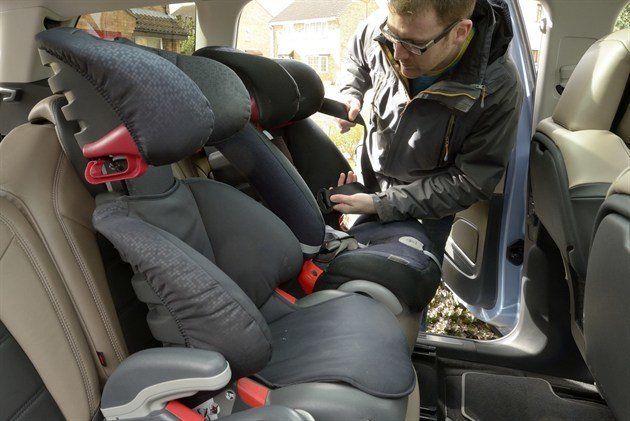
The Grand C4 Picasso can easily take three child seats across the back
Under the bonnet, is an economical and environmentally friendly four-cylinder 2.0-litre diesel. According to the official figures, it should return 65.7mpg with CO2 emissions of 105g/km. That puts it in VED band B – or just £20 for 12 months. But don’t think just because it’s frugal it’s not powerful. It takes 9.8 seconds to get from 0-62mph and has 152PS at 4000rpm, but – more importantly – a whopping 370Nm of torque at just 2000rpm. Even when you’re seven-up, that kind of power should make overtaking a lorry uphill a breeze.
Inside, the cabin is light and airy with plenty of high-quality plastics (certainly on the top half, anyway) giving it a more premium feel than some previous incarnations of the car. Our test car has the amber/black nappa leather option, which at £2000 isn’t cheap, but is definitely hard wearing. And wipe clean, which is handy when you’ve got kids.
I’ve got two of them and I can tell you they’re going to love this car. The second row has picnic tables, there’s a panoramic sunroof so they can see the clouds, the second row can have three child seats across the back, and there’s a third row of seats for taking unsuspecting in-laws on days out. But it’s not just the kids who are going to find the big Citroen handy to have around.
When I’m not editing the Honest John Classics website, I moonlight as a guitarist in a local rock covers band. So two or three times a month, I have a huge speaker, amplifer, two guitars and two sub-woofer speakers to drag around. The fact that the Citroen has an almost van-like load space is going to be a real bonus over the next six months.
Parking? It's a problem
Keith Moody gets to grips with the self-parking system on our long-term Citroen Grand C4 Picasso. Which has been nicknamed Pierre.

Date: 26 March 2015 | Current miles: 2541 | Claimed economy: 65.7mpg | Actual economy: 41.7mpg
‘Pierre might be a bit grumpy this morning,’ chirps Emily. My daughter may only be five years old, but she’s well aware that our long-term Citroen Grand C4 Picasso is not a morning person. When Emily heard we were getting a car that could park itself, she was over the moon and couldn’t wait to tell all her friends at school. But, sadly, the day-to-day reality is that the big Citroen is far from capable in this department.
On paper, a self-parking car sounds like a great idea. How many times have you driven past a space wondering if you could squeeze your car into it? I do it a lot. There aren’t many parking spaces outside our school or nursery – and fortune does favour the brave. Our long-term Honda Civic Tourer didn’t self-park, but it did have sensors all-round and a cracking reversing camera, which meant it could be shoehorned into the tightest of spots with confidence.
Things should be even easier with the Citroen. Just tell it what kind of parking you need to do (parallel or bay), stick your indicator on and off you go. On the days that it does work, it scans the road as you drive along, finds a space, beeps to alert you and then you just follow the on-screen instructions. You’re still in charge of the throttle, braking and the gears, but the computer takes care of the steering.
However, most mornings I just end up parking it manually. Some days you’ll instruct the car to scan for a space and you’ll drive past something big enough to park a bus in, but the sensor won’t register it. Other days, the sensors refuse to activate at all (there’s a little radar and a green ‘P’ that show up on the main screen to tell you the system is active… or not). The worst days are when ‘Pierre’ (as we call the Citroen) makes a bad decision.
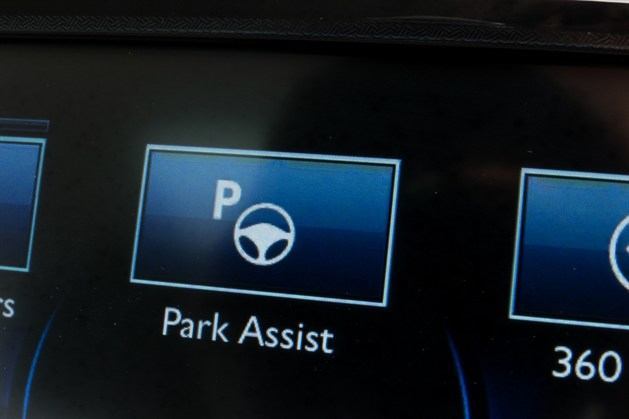
Park assist: sometimes good, but most often bad
At first I thought its parking misdemeanours were a one off, but they're not. Parking at our local train station is incredibly tight. The car park might have been recently refurbished, but the parking bays are still marked out at 1965 spec - you’d struggle to get a Morris Minor between the lines. Our Picasso is considerably bigger than a Moggy (as are most modern cars) so the bay park function should be a lifesaver… especially as choice is limited after 8am when you can count the number of available space on one hand.
Having driven past two pefectly good spaces, Pierre opted for a third way. I could have taken control, but I was curious to find out where Pierre was going with this. After about four minutes, the answer still wasn’t clear. Peirre had found himself a ridiculously tight spot and was trying to wedge himself into it. I searched frantically through the menu options – did the Citroen still think it was in France? Was it about to nudge park its way in? Did I put Merlot rather than diesel in the tank?
In the end, I was manually trying to fold in the door mirrors for fear of the car ripping off its own external parts. ‘Parking complete’ bonged the computer triumphantly. Apart from the fact, I couldn’t exit the vehicle. Yep, Pierre just loves to pick the wrong space. At our local soft-play centre, it tried to park in the space left for the pay and display machine. Even better - the sensors use the car next to it to line up. If the vehicle in the next bay is on the wonk, you will be too. Another time, Pierre picked a space that was already being occupied by a tiny (but still there) Fiat Seicento.
When the system does work as you’d want it to, it’s great. That space outside nursery that everyone’s avoided is yours for the taking. Leaving you loooking like a parking hero. Even better, it’ll get you out of that space in one go (it’s much braver than me as the sensors go wild). Sadly, the system is so inconsistent that most of the time I just park the car myself. Keep it old school, that’s what I say.
Can our Citroen cope with the Easter break?
Our long-term Citroen Grand C4 Picasso gets its first major test - the Easter family holiday. To Butlins.
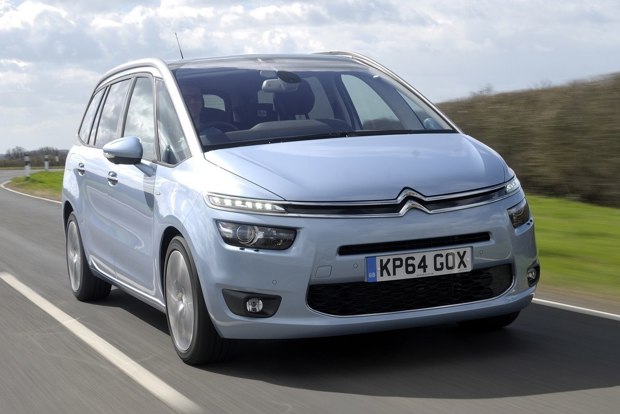
Date: 9 April 2015 | Current miles: 2893 | Claimed economy: 65.7mpg | Actual economy: 41.7mpg
It’s Easter. And that means our long-term Citroen Grand C4 Picasso is about to face its first major test – the family holiday. This year, the four of us are off to Butlins in Bognor Regis. Yes, yes, I know… but it’s great for the kids. And besides, I reckon I’m in with a real chance of winning the knobbly knees contest this year.
But enough about my perfectly formed patellas, before we even get to join the red coats we’ve got to get there first. And that means a 150-mile drive that includes such heady traffic hotspots as the A14, the A1, the M25, and the Chichester bypass. Did I mention we’re travelling on the Easter Monday bank holiday? Add in two children to the mix and a sprinkle on another two hours to the journey time to take account of traffic jams and toilet stops and we’re guaranteed a pretty hellish trip.
Still, that’s what school holidays are all about. Or at least they were when I was a kid. A holiday wasn’t a holiday unless you got the back of your legs burnt by the scorching hot vinyl seats in a Ford Cortina. No such rites of passage here, though – our big Citroen is equipped with all mod cons to keep the kids amused and the parents as relaxed as possible. Apart from DVD players in the headrest.
No problem. A short trip to Argos and £80 later our two are looking forward to watching Peppa Pig 37 times in a row on our trip to King George V’s favourite getaway. But just five minutes into our trip to the land of chalets and queues for everything, we have hit a problem. Emily, my eldest spots it first, ‘Pig’s broken.’ Charlotte is less philosophical about our bacon-related trauma, preferring to treat us to a primeval scream.
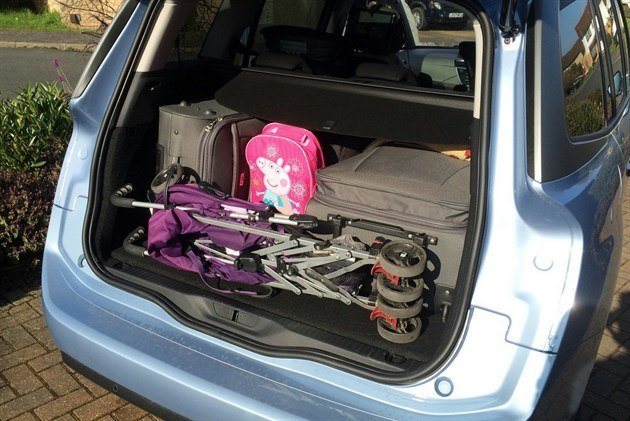
Luggage for four people barely fills the big Citroen's epic boot
The problem? The Grand Picasso’s massive headrests are so big that the recently purchased DVD players can’t be securely fastened to them, causing the screens to go on the wonk every time we go round a corner. Luckily, it’s a fairly straight journey after the first five minutes so we make do and mend. As soon as we hit the first traffic jam, I catch my wife fiddling with the passenger seat. She’s discovered the foot rest, the in-built massage facility and is all set for a snooze.
Meanwhile, the kids in the back are complaining that they’re hungry. Even though three bowls of breakfast only happened 27 minutes ago. Thankfully, the Citroen has picnic tables in the back that they can rest their raisins and Ribena on. For the time at least, they couldn’t be happier. As we crawl round the M25, I open the panoramic roof so they can see the planes coming and going at Heathrow airport.
Up front, the Citroen is remarkably relaxing to pilot through the gridlock. The door mirrors have blind spot warnings, which is handy given the amount of motorbikes that come steaming through at 40mph when everyone else is doing 5mph. The stop-start system is also well thought out, cutting the engine when you’re in neutral and below 5mph, which means that dipping the clutch to engage a gear ready to move forward restarts it. Intuitive, I think, is the word I’m looking for.
And then there’s the sheer-load lugging ability. The boot has chomped two full-size suitcases, two smaller suit cases stuffed with toys, a stroller and bag for the food without even looking full. And even four-up with luggage, the performance from the 2.0-litre diesel is undiminished. For once, I arrive at our chosen holiday destination feelingly marginally relaxed. Don’t think my dad could say that after nearly six hours at the wheel of the Cortina. I did sort of miss the traditional Ford-based holiday breakdown, though – although I’m sure the wife and kids were happy we hit Sussex without overheating.
Citroen and the lost art of map reading
Keith finds the satellite navigation system in our long-term Citroen Grand C4 Picasso isn't always up to the job.

Date: 23 April 2015 | Current miles: 3383 | Claimed economy: 65.7mpg | Actual economy: 48.0mpg
Three, two, one – and you're back in the room. Using our Citroen Grand C4 Picasso’s satellite navigation system is a bit like constantly being put to sleep and then woken up to the sound of a hypnotist clicking his fingers. One minute everything’s fine, the next you could be anywhere: a train station car park, a lake, in the middle of a field...
The problem is this: after starting your journey to wherever it is your going, the Citroen’s navigation system is at the mercy of some very French electrics. You’ll be driving along and then all of a sudden the system will crash. Just like your PC at home. The audio goes off, the screen goes blank and you're left completely in the dark for a good few minutes.
Of course, this techno meltdown normally happens at a fairly crucial point in your journey. The other night, I was on my way to play a gig with my band in a town that I’d never been to before – and one that had a fairly unforgiving one-way system to negotiate. I’m sure that the locals know how to beat it, but I was clueless – and missing an exit would put me on it for another six- or seven-minute lap. Sure enough, at the critical moment, the screen went dead and I missed my exit. It’s infuriating, and there seems to be no rhyme or reason to it.
When it comes back round, the mapping system often has no clue where it is. Sometimes it goes back to the last point it was at before it crashed, other times it just puts you in the middle of a field. And it’s not quick to regain consciousness.

Relying on Citroen’s navigation system can leave you in the dark
Of course, I could just plan my journey beforehand using a map and not rely on the in-built navigation. But if I had any sense of direction, then I wouldn’t have chosen the nav option. And it’s not that cheap an option, either - £550, including VAT. Give me a £90 entry-level Tom Tom Start any day.
Sadly this isn’t the navigation system’s only shortcoming – Citroen’s system doesn’t use postcodes. That means inputting a destination is a slightly more laborious task than it should be (compounded by a hard to use and clunky touchscreen system).
You need to enter the country you’re going to (if the destination is outside of England), then specify the town, before adding the street address and house number… if you’ve got it. I hadn’t realised this, so had to pull over en route and phone the venue from the side of the road. In an area that had limited mobile signal. Have you tried finding and using a phonebox recently? It’s not as easy as it used to be. This isn’t 1997, after all. More's the pity.
Times and tech have changed, but Citroen hasn’t – it’s still cutting-edge and forward-thinking, but not always reliable. But as someone who is a big fan of Citroen’s cars from the 1960s and 1970s, I find myself forgiving our Grand C4 Picasso (although a more demanding customer certainly wouldn’t). Unlike so many good, reliable modern cars, at least our Picasso is it a bit interesting. It has, how do you say, a certain ‘je ne sais quoi.’
Our workhorse Citroen proves a big hit
If you need an MPV that can double as a load-lugger, the Citroen Grand C4 Picasso is worth a look. As Keith finds out.

Date: 7 May 2015 | Current miles: 3745 | Claimed economy: 65.7mpg | Actual economy: 48.0mpg
Bank holiday’s used to mean a day spent larking about with mates. A few beers, some crazy golf and a dalliance with food poisoning after someone decided it was a good idea to fire up the barbecue. Either that or you’d wake up early, spring out of bed full of exciting ways to make the most of the holiday, before regressing to a slumber state on the sofa and watching trash television, overwhelmed by a sense of remorse at wasting the day (or not getting your homework done).
Nowadays, bank holidays mean only one thing. Those three little letters: D.I.Y. Yes, barely one seems to go by without another room getting ripped apart or the family being shoehorned into the car for a trip to Ikea. The early May bank holiday was no different as we’d decided it was time to decorate the bedroom of our youngest daughter.
That meant tearing apart all manner of fixtures and fittings, attacking bits of skirting board, ripping up carpet, taking down blinds - you get the idea. Collateral damage included an iron and an accident with a stuffed bear that was being used as a human shield at one point. By lunchtime, the room was reduced to an empty shell and my younghest was heard complaining ‘Mummy broke my room’ as her mattress was set up in her sister’s bedroom.
With so much debris to dispose of, we seriously considered hiring a skip. Or a man with a van. But then I remembered that I was a man with a van. Sort of. Thanks to those clever people at Citroen, our long-term Grand C4 Picasso is the perfect vehicle in these testing situations. Not only do all the seats fold flat at the pull of a chord, but they can also be easily removed to create a completely flat, van-like load bay. The seats are quite heavy, though, so before you start pulling them out you need to make sure you’ve got the strength to get them back in.
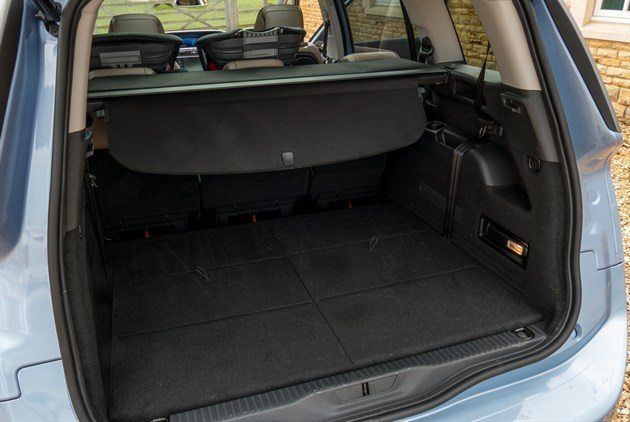
Big Citroen's van-like boot makes it a practical family car
In the blink of an eye, the big Citroen went from being a mobile child’s playpen and picnic palace to a proper working vehicle. I threw my copy of The Sun on the dashboard, grabbed an egg buttie and headed off to our local tip. Fully in character, I grabbed my mobile phone so I could do a bit of multi-tasking en route and talk about the match with my old man, know what I’m saying, geezer? Er, apples and pears. Etc.
Then I remembered the infotainment system included Bluetooth for just such an occasion. After a bit of faffing about, codes were exchanged and I was ready to use the in-car hands free kit. As far as call quality goes, you can’t really fault the Picasso. It’ll hang on the signal as long as your phone’s got coverage. And it’s one of the few systems where my dad didn’t immediately ask if I was driving, or repeatedly say that he couldn’t hear me. I either caught him on a good day, or the Citroen is pretty good in this department.
Of course, it wouldn’t be a Citroen update if we didn’t point out a few quirks. For example, there’s no way of importing your favourites for speed dial shenanigans, or even accessing your recent calls for quick dialling. Even though you exchange what feels like hundreds of phone calls with your wife every day, you still have to go through the tedious A-Z menu to find her number.
Other highlights include a rather confusing thing that happens when the person you're calling goes to voicemail - the system thinks the caller has hung up and returns you to a previous screen (navigation, music). Which leaves you scrambling for the phone button and trying to figure out how to end the call. Most of the messages I leave for people include a good two minutes of silence and swearing at the end. These aren't the only quirks from the infotainment system – I’ll run you through those next time. But right now, I’m enjoying the Picasso’s status as easily the most useful vehicle on the fleet. Who fancies a bacon sarnie?
Citroen's very own gadget show
Our Citroen C4 Grand Picasso is loaded with gadgets and driving aids. But are they a help or a hindrance?
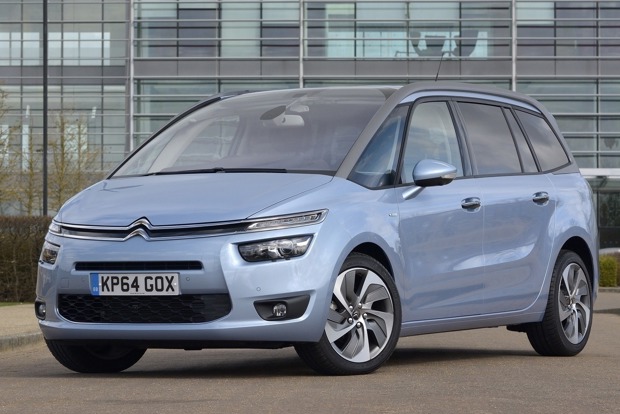
Date: 21 May 2015 | Current miles: 4430 | Claimed economy: 65.7mpg | Actual economy: 49.9mpg
Our Citroen has a funny way of putting things. When you’re on a long journey in the Grand C4 Picasso and dialled into the satellite navigation, you often find that instructions are a bit clipped. Take the number of a junction, for example, if you need to leave at junction 25, you might hear it say ‘twenty fiv…’ or sometimes just ‘twen’ before the instructions cut off.
It’s not just that navigation either. A lot of the user interface seems counter-intuitive. Perhaps we’re just a spoilt generation with our easy-to-use iPhones, but I find that the Citroen uses ten words where two will normally do. When you get a traffic announcement it flashes up ‘Announcement. Interrupt announcement?’ It took me a while to figure out what it actually meant, but it’s asking if you want to cancel the traffic bulletin and return to what you were listening to.
I’ll confess that most of the time the car gives me an instruction, I don’t have time to read all of it – so long and detailed is the on-screen information. It’s not too bad if you’ve got a passenger with you, but when you’re on your own, other things are more important. Like concentrating on the road.
That said, our big Citroen does its best to make your life as easy as possible when you’re on a long journey. For a start, there’s the adaptive cruise control – just set your speed and it’ll keep you 1.5 seconds away from the vehicle in front. Braking and accelerating is done automatically. You don’t get to nod off, though, because if the car in front brakes sharply or you get cut up by another driver then a beep lets you know the cruise control has been disengaged. It’s a helpful tool, but it’s often surprised by slightly slower moving traffic. Set it at 70mph on a motorway and it’ll steam up behind a lorry doing 55mph and disengage – even though the lorry’s been there all the time.

Citroen's display packs in plenty of information
Then there’s the lane departure warning system. This clever device tugs at your seatbelt if it senses you wandering into another lane. I’d love to know how it works because it doesn’t react where existing lanes have been covered over during roadworks, yet it still works at night. Perhaps it works as light is reflected back to a sensor from road markings.
One area that could do with a bit more light is the reversing camera. Fine during the day, utterly hopeless and pointless in the dark. Another thing that is missing from the car’s box of tricks is speed-sensitive volume adjustment. You often find yourself fiddling with the volume dial as road speed (and therefore road noise) increases and decreases.
We’ve already talked about the Citroen’s problem parking, but I have found its 360-degree ‘parking vision’ quite useful. As so many modern cars are designed with soft, flowing curves, I find it can be very hard to spot the corners of the vehicle when parking. Not like, say, a Mk2 Granada - but then that did have the aerodynamics of a house brick. With Citroen’s vision 360, you can ‘see’ the proximity of objects all around the car displayed on the screen, which is incredibly handy if you have to get in and out of a tight spot.
The Citroen’s gadgets will please others, and disappoint some. But strip them away and one thing is clear: the Citroen Grand C4 Picasso is still a hugely capable family car with acres of space, a powerful engine and decent fuel economy (it’s improving as we cover more miles). Yes, it may have its eccentricities, but I’ll settle for that over a more boring model any day.
Grand Picasso proves a competent companion
It might be as practical as a van, but our long-term Citroen Grand C4 Picasso doesn't drive like one.

Date: 4 June 2015 | Current miles: 4537 | Claimed economy: 65.7mpg | Actual economy: 49.4mpg
A friend of mine used to own an early Xsara Picasso and while he often marvelled at its capacity to carry the family in comfort, he didn’t say much about how fun it was to drive. I suspect, having waved goodbye to his mid-1990s Alfa GTV, it was a bit of a shock to the system. Especially as the early Picasso’s were always a bit of bus to hawk around the ’burbs.
It was almost as if someone at Citroen wanted to remind the driver on a daily basis that the fun times were over. And that’s a pretty un-Citroen thing to do. After all, with the CX the French car maker gave us a car that went up and down. And that party trick never fails to raise a smile.
Of course, the Picasso range improved and so did the handling. By the time we were waving goodbye to the Xsara Picasso (and the Brown family were waving goodbye to Number 10) in 2010, the Picasso had become fairly good fun to drive. But I still remember my first journey home in our long-termer wondering if I’d have to buy myself an MX-5 for high-days and holidays and how I’d get that one past the wife.
Luckily, there was no need (although a tidy and completely standard F-reg Mk1 Eunos would be a welcome addition to the driveway). I wasn’t amazed at how well the Citroen coped with the m-way slog and the stop-start traffic – that was what I’d expected. I’d also expected it to end up on three wheels at the first sight of a corner taken a little bit too quickly.
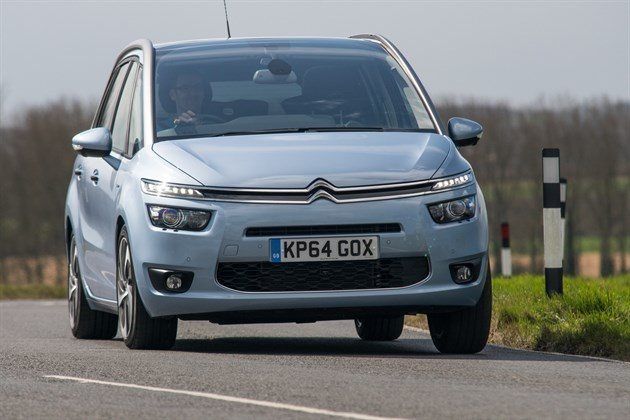
Our long-term Citroen Grand C4 Picasso copes admirably with A and B roads
How wrong I was. The big Citroen copes admirably with pretty much anything you can throw at. Gear ratios are well-spaced for gentle cruises, and yet still offer enough options should you find yourself with a twisty road ahead and a clear view. Even fully-loaded, there’s still plenty of power from the diesel engine under the bonnet. That diesel engine is one of the car’s strongest points, actually. And the more miles it gets under its many, many belts, the better it seems to perform.
I remember when the 2.0-litre HDi unit first came out in 1999/2000– it was Citroen’s first common-rail diesel engine, which sounds like a mouthful but basically means a happy marriage of economy and performance. Unheard of back in the 1990s for those (like me) that were used to Ford’s 1.4-litre turbocharged diesel, which offered neither refinement, performance, nor economy. If I remember correctly, the 2.0 HDi first appeared in the Xsara and the Peugeot 306 with 90bhp. But while those early engines were a bit breathless and suffered from a lack of power lower down the rev range, plenty of R&D has been done over the years and the latest version is hard to fault. In fact, the 16-valver here is Euro IV compliant and emits just 110g/km of CO2. Which, in plain English, means it's 'green' and costs just £20 a year to tax.
The latest 2.0-litre has got a bit more poke than those earlier engines, too. For a start there’s 150PS, but the real ‘wow’ factor comes from the 370Nm of torque available from, well, pretty much anywhere. In every day driving terms that means you’ve got plenty of shove right where you want it. Need to overtake a slow-moving lorry uphill when you’re seven up? No drama. Not as impressive as having a V12 under the bonnet, I’ll give you that, but definitely cheaper when it comes to filling up.
If you are in real hurry, the big Citroen will get you from standstill to 62mph in 9.7 seconds – which is only 0.7 seconds slower than a Mk1 Volkswagen Golf GTI. And the fuel economy is improving as the miles pile on. We’re now just a smidge under 50mpg and hoping that we’ll get closer to the official figure of 65.7mpg before we (reluctantly) hand the keys back in September. So, all told, Citroen’s flagship people carrier has come a long way in 25 years. Even better, owning one means the fun times can continue, even though you’ve said goodbye to the sports car and are now being rapidly outnumbered by small children asking ‘are we there yet?’
The good, the bad, and the ugly side of living with a Citroen
Those pesky electrical issues continue to niggle, but our big Citroen is still a strong performer.

Date: 29 June 2015 | Current miles: 5019 | Claimed economy: 65.7mpg | Actual economy: 46.8mpg
One of the best things about our Citroen Grand C4 Picasso is the engine. It’s a 2.0-litre diesel mated to a six speed gearbox. And despite having ‘only’ 150PS, it has 370Nm of torque, which means it might not be the quickest car away from the lights - but in real world driving conditions it is excellent.
It’s quiet, has plenty of pulling power so that you’re not mashing through the gears when you need to overtake a lorry uphill, and it’s economical. Reasonably. The official fuel consumption figure is 65.7mpg, but we never get more than 50mpg. It’s best figure on a tank was 49mpg, but it has been as low as 41mpg.
That mirrors your experiences with the car, too. According to our Real MPG data, the average economy for the Citroen Grand C4 Picasso 2.0-diesel manual is 49.8mpg. For a car this big, and this capable, that's not bad at all. The big Citroen would still be my choice if I was in the market for an MPV – the Citroen with this engine has got to be one of the best combinations in this corner of the market.
The latest addition to Citroen’s engine family is its new three-cylinder engine, which will be making its way up the range to this seven-seater. If you mainly use your multi-purpose vehicle to carry people (both big and little) around town, then this engine might make sense for you. According to the official figures, the three-cylinder should return 57mpg and get you to 62mph in 10.8 seconds – all for under £20,000. It’s a lower-spec car, but it makes the big Citroen people carrier an even more attractive proposition. We’ll wait until we’ve driven it before giving a full verdict, though.
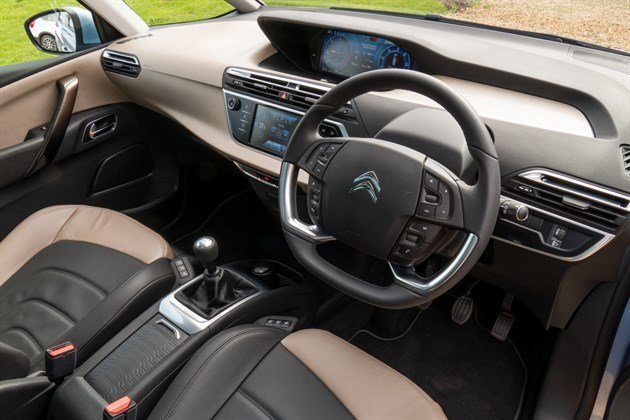
Behind the wheel of the big Citroen is the best (and sometimes worst) place to be
Hopefully at some point over the next 12 months, Citroen will takes steps to improve its infotainment system, which is slow, sticky and unreliable. In fact it's starting to spoil things. If you’re trying to be good and get everything ready before you set off on a long journey, then you’ll need to make sure you factor in an extra five or ten minutes.
Sometimes it can take two or three minutes just to turn on. And, if you’re a little impatient, it can get very upset. Example: I was trying to access a playlist from my iPod, which is connected via a USB cable. After two or three attempts, I gave up, and opted to adjust the temperature (all still controlled via a touchscreen).
‘Pierre’ (as we call the big Citroen) did not like that one bit. The screen froze up for a good two or three minutes. When it eventually came round, I was able to turn the heating back down – the numbers on the screen had jammed, but it the heating had shot up to run flat out. Eventually the system crashed and it just turned itself off. With virtually everything controlled by the touchscreen, a simple thing like adjusting the temperature can become a major problem.
This strop has become such a regular thing that I’ve actually learnt to listen out for it. Like those old mobile phones you used to get ten years ago that made a barely audible electrical noise just before they were about to chirrup. Our Citroen’s strop is normally preceeded by a blip noise – which is useful because if you’re relying on the navigation you know it’s about to abandon you.
Had something similar happen to you? Tell us about it via our Owner's Reviews.
Electrical gremlins give our long term Citroen a hard time
With just under 5000 miles on the clock, our Grand C4 Picasso has developed a few niggles.

Date: 18 June 2015 | Current miles: 4721 | Claimed economy: 65.7mpg | Actual economy: 49.4mpg
It all started when the key ring fell apart. That was just days after being handed the keys to our Citroen Grand C4 Picasso. As I glanced down at the two pieces that used to be joined together – the Citroen badge on the fob had split in completely in half - my suspicions about build quality were aroused. But I dismissed them – things have moved on, I told myself. But they haven’t.
With just under 5000 miles on the clock, the first thing to go ‘intermittent’ was the button on the key fob that opened the rear boot. Sometimes it does, sometimes it doesn’t. At least the button on the boot itself still works, though.
Inside the boot, there’s another casualty. The Citroen’s excellent seating system means that both rows of rear seats fold down to create a fully-flat load space. The back of each seat in the second row has a board that flips over to help create the even surface.
It’s a great trick (and has been very useful over the past three months) but the boards aren’t very hard wearing. They feel like they’re made out of thin pieces or MDF or plywood and, as a consequence, aren’t very good at supporting a heavy load. I found this out when I put my guitar amp and speaker in the car once. I didn’t managed to land it fully on the back of the seat, instead the weight went on the board. And the board split.

Electronic parking brake doesn't always engage when you ask it to
Other niggles are related to the electrical system. The infotainment system still turns itself off. Normally when you’re using the satellite navigation and you’re about to reach a junction or some other point in the highway that requires a decision to be made.
And then there’s the self-parking system. Never the car’s best feature, this has now retired itself from active service. You call up the relevant screen on the centre console, select park assist, but you can’t select any of the categories (bay park, parallel park, exit parking space). No great loss, I suppose.
Perhaps the failing that is most concerning is the electronic parking brake. Unlike some cars, there’s no auto hold here. If you’re on a hill and you come to a stop, you need to press (or pull – I can never remember) the parking brake switch. I first found out it wasn’t 100 per cent committed to the cause when I engaged it, but the brake didn’t engage, causing the car to roll back. Quick thinking and even quicker feet were required to prevent a claim.
It’s a shame, because unlike so many of these systems, the release mechanism feels fairly natural – you don’t feel like you’re about to burn the clutch out before the parking brake is released and you're sent surging forward. Why manufacturers ever felt the need to include this bit of tech in cars has always been beyond my understanding. Still, one thing’s for sure, life with our Citroen is never dull.
The cost of innovation
Our Citroen - like many of its predecessors - is an innovator. But innovation comes at a price as Keith Moody finds out.

Date: 16 July 2015 | Current miles: 5453 | Claimed economy: 65.7mpg | Actual economy: 42.9mpg
As a manufacturer, Citroen has often been ahead of the game. As far back as 1934, it pioneered the technology that has formed the foundation of modern car design.
While not the first front-wheel drive car, the Traction Avant of 1934 gave us a front-drive car with unitary body construction – rejecting the ladder frame chassis designs that were popular at the time.
And Citroen didn't stop there. Twenty years later, the car maker pioneered development of high-pressure hydraulics to create a self-levelling suspension – or rather, that magic carpet ride. It’s a system that inspired and informed the Rolls-Royce Silver Shadow and the Mercedes-Benz 600.
In 1955, its DS was the first mass produced car to get disc brakes. And you know those lights that turn with the steering wheel that BMW made such a fuss about a few years ago? Yep, Citroen got there first.
Its pioneering work in the field of aerodynamics helped to improve performance and fuel economy. We take it for granted nowadays, but if it hadn’t been for the DS and Citroen’s CX (a name which is literally the measurement of drag co-efficient) then we might still be driving round in cars that look more like house bricks than sleek, air-slicing streamlined phantoms.
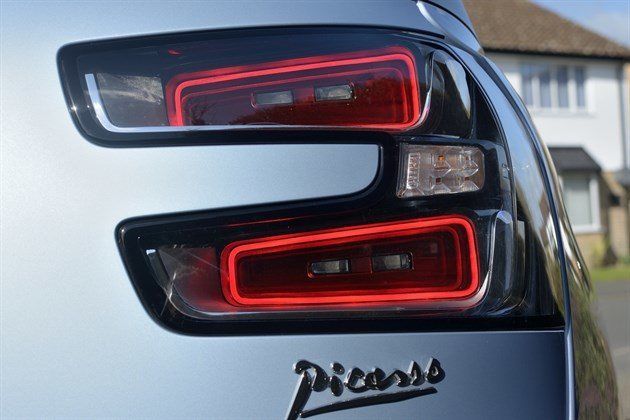
Our big Citroen carries the name of another innovator
So this week’s news that the French car maker is to get a new heritage centre is most welcome. I’ve been fortunate enough to visit the current Conservatoire in Paris and it is bonkers. Wonderfully, incredibly, mind-blowingly bonkers.
Of course, it contains a few howlers but it’s all interesting stuff. What does this have to do with our long-term Citroen Grand C4 Picasso? Well, innovation comes at a cost… as I’m finding out.
Our long-termer is loaded with kit that’s designed to make your life easier but, sadly, it can’t always be called upon when you need it most. Take the navigation, for example – it often can’t be used first thing in the morning (i.e when you’re setting off on a long journey).
The same is true of the park-assist. And the blind-spot warning lights have started giving false readings, or not spotting cars in the blind spot. Then there’s the reversing camera, which doesn’t work in the dark. Still, I’d rather be driving a car that tries to innovate than one that doesn’t any day of the week. After all, if you want to do something new – you have to stop doing something old.
Why our big Citroen can leave you in the dark
Driving our Grand C4 Picasso at night isn't quite as good as it should be, finds Keith Moody.

Date: 27 August 2015 | Current miles: 5977 | Claimed economy: 65.7mpg | Actual economy: 47.7mpg
Back at the dawn of the automotive era, night time progress wasn’t really the done thing. If you had to go out after sundown in your Ford Model T, you had to rely on carbide lamps. More than a hundred years later though, there really is no excuse for a car that’s – well – a bit rubbish in the dark.
And our Citroen C4 Grand Picasso is just such a car – it is not a night owl. Which is a bit odd, really, when you think how much attention the designers have paid to getting light into the car. Vast expanses of glass cover our Citroen, making the cabin feel light and airy. Our car is equipped with the panoramic sunroof, which is a fantastic at keeping the kids occupied on rainy days. Or watching planes come and go from Heathrow when you’re stuck in traffic on the M25.
There are also lots of nice little touches to make the cabin your happy place. The sun blinds travel forwards and backwards (go nuts sun worshippers) and chunky windscreen pillars clad in black plastic are binned in favour of see-through ones that minimize the blind spot when pulling out of junctions.
Then there’s the clever headlights that can see round corners. These constantly adjust their angle of direction as you turn the steering wheel. They can even dip themselves, which along with automatic self-adjusting cruise control, is another neat way that Citroen has taken some of the hassle out of driving. There are also plenty of bright LED interior lights so you hunt down that missing bunny on those late-night journeys home.
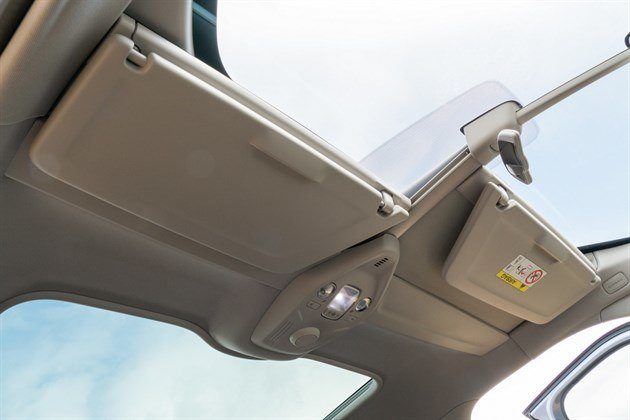
Citroen's cabin is full of neat touches like blinds that move forward and back to let the light shine in
But it’s in the dark when a few of the Citroen’s niggles become apparent. For a start, there’s the automatic headlights, which are constantly changing their mind about whether they need to be on or off. And I’m not talking about when you’re going through a tunnel, either – this is just bimbling around town. It was the same when these systems were first introduced over ten years ago, so I’m amazed that they haven’t improved since then. Still, at least it’s a problem overcome by switching to manual.
And that can be a problem in this car-come-spaceship. Take the heating for example – if that infotainment system is playing up you can’t adjust it until it sorts itself out. There’s no manual switch for that. And there’s no manual switch to adjust the brightness of the dials, either. So if the system decides you need the lights on at 3pm with the sun glaring in, your dials are automatically dimmed. And that can make reading things like the speedo very tricky.
But the real let down when it comes to driving our Citroen at night is the visibility when reversing. Perhaps it’s just me, but the reversing lights don’t seem bright enough. And don’t think you can rely on the reversing camera, either – it is utterly hopeless in the dark. Unless you’re backing into a well-lit space, you’ll just be contemplating a black screen with some green and red lines. Needless to say, I daren’t trying the self-parking mode at night. It’s bad enough in the daytime.
It underlines a point we’ve made about this car since day one: as a family car, this is an excellent choice – we love it and will be genuinely sad to see it go. But the tech it’s been loaded with can be something of a let-down. So save your money and buy one with fewer toys and less to go wrong.
Time to say farewell to our Citroen C4 Grand Picasso
After six months, we assess at the pros and cons of Citroen's seven seat people carrier.

Date: 18 September 2015 | Current miles: 7009 | Claimed economy: 65.7mpg | Actual economy: 45.9mpg
There were tears, there were tantrums. ‘I don’t want the Citroen to go, daddy’ screamed my youngest daughter. And I can’t say I blame her. Every trip in the Citroen C4 Grand Picasso is fun – whether you’re popping to the shops or going on a family holiday. It’s like a fully kitted out Early Learning centre on wheels. The kids love it. And I’m quite fond of it, too.
The cabin is light and airy thanks to those see-through A-pillars and huge windscreen. And our car had a huge panoramic glass sunroof so you can watch the rain hammer down when you’re stuck in traffic on the M1 on Bank Holiday Monday. There even are picnic tables with their own reading lights – this pretty much guarantees that any long journey requires a packed lunch.
Thankfully, our big Citroen’s interior is quite hard-wearing and fully raisin resitant. It’s leather is easy to wipe down after the most devastating squash spillage, while chocolate, crisps and all kinds of other mess can be quickly hoovered up. Oh, and the second row of seats can move backwards and forwards, which means that neither my six year old nor my three year old can kick me in the back while I’m driving. Result.
Pop up the third row of seats and there’s space for seven people in the party wagon. So visits to the in-laws by the seaside (and subsequent trips to the beach) no longer requires the use of two cars. The Citroen C4 Grand Picasso is one of those rare cars that makes every journey fun.

Citroen easily seats seven adults with room for their luggage
And for the driver, it will change your perception of the MPV for the better. Forget all those stories you’ve heard about them handling like a bus. This Citroen can tackle the turns and twists of any B-road with the best of them. Okay, so it’s a little bit leany but you get used to it. And anyway, performance driving will be the last thing on your mind as you’re belting out a Frozen-inspired sing-a-long. Rather have an M3? Let it go…
The 2.0-litre diesel engine in our car is not only environmentally friendly and easy on the wallet, it’s seriously strong. Seven-up with luggage, it can scoot round traffic – trucks, caravans, dawdling Honda Accords can all be dispatched with safety. Most of the time you don’t even have to change down to fifth from sixth. How something that returns just shy of 50mpg can have so much torque is beyond me. It’s probably witchcraft.
Grumbles? Well, after six months with the car we’ve been able to spot a few things you might not notice on the test drive. Our high-spec infotainment system has a mind of its own, for example. So not only will you struggle to set the (postcode-less) satellite navigation first thing in the morning, you’ll also struggle to change the temperature or fan speed on the heater. Or the radio.
Park assist was intermittent at best. The keyless entry only ever set the alarm off and didn’t work in the wet. But if you can live with these (or just buy a mid-spec car) you won’t be disappointed. The Citroen C4 Grand Picasso is one of the best Citroen’s they’ve made in years. And, at last, it’s an MPV that is fun, frugal and fast.
